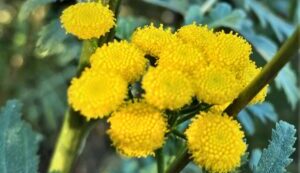We selected Tansy as plant of the month for June because of the plant’s insect repellent property, e.g. ticks. You can easily make your own bug spray by cooking a tansy tea. More about that later.
Tansy (Tanacetum vulgare) is a perennial plant of the aster family, native to Europe and Asia. It grows very well in Massachusetts, up to the point that it can be invasive. It has fernlike leaves and blooms yellow in summer (see picture). Tansy was used as herb to flavor omelets or baked goods and also in traditional medicine, for example to treat internal worms. However, as the flowers and leaves is toxic to the liver if consumed in great quantities, the use of tansy for internal human consumption is no longer advised, even not in small quantities. Tansy however is great in companion planting and can be used for biological pest control. While bees love tansy, many pests don’t like the smell. For example, it is said that tansy planted near potatoes will repel the Colorado potato beetle, tansy is also used to protect cucumbers and squash, or with roses or various berries from pests. It is thought to repel ants, cucumber beetles, Japanese beetles, squash bugs, some kinds of flying insects, and even ticks.
How to make Tansy Insect spray:
To make a basic bug-repellant tansy spray, you can use either 1 cup of packed fresh tansy leaves or 1/3 cup of dried ones per one cup of boiling water. Let the leaves steep until the water has completely cooled, then pour through a strainer or sieve. It’s important to remove all plant debris. Then pour the tea into a sprayer. If you use it as bug spray on plants, add a teaspoon of dish soap and mix well. The soap will help that the mixture adheres to plant leaves. This spray will last a few days in the fridge. Currently, we are selling a few tansy plants at the farm stand. If you just want to try the bug spray, you can also purchase cut tansy leaves from us. Please email Christiane.

